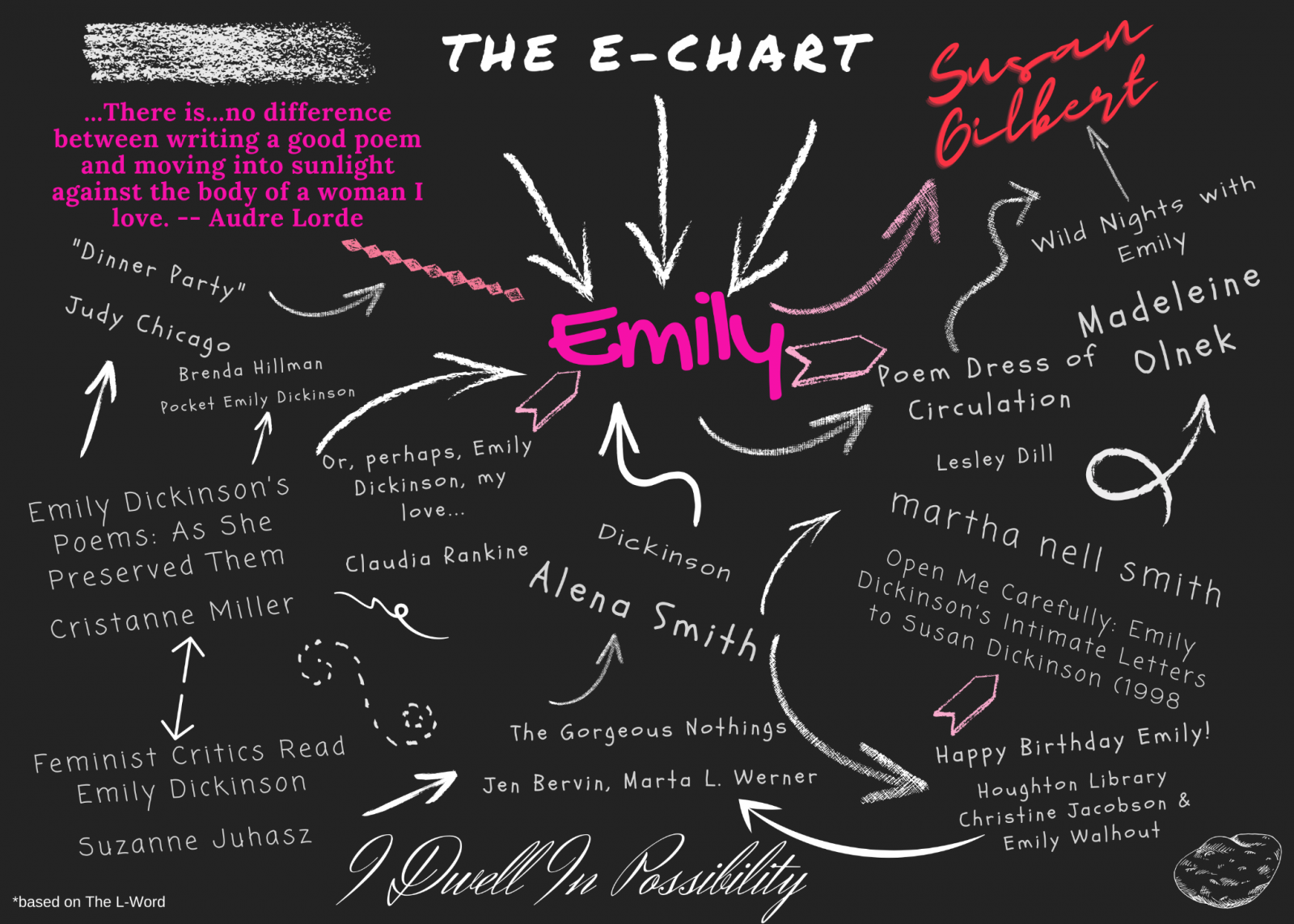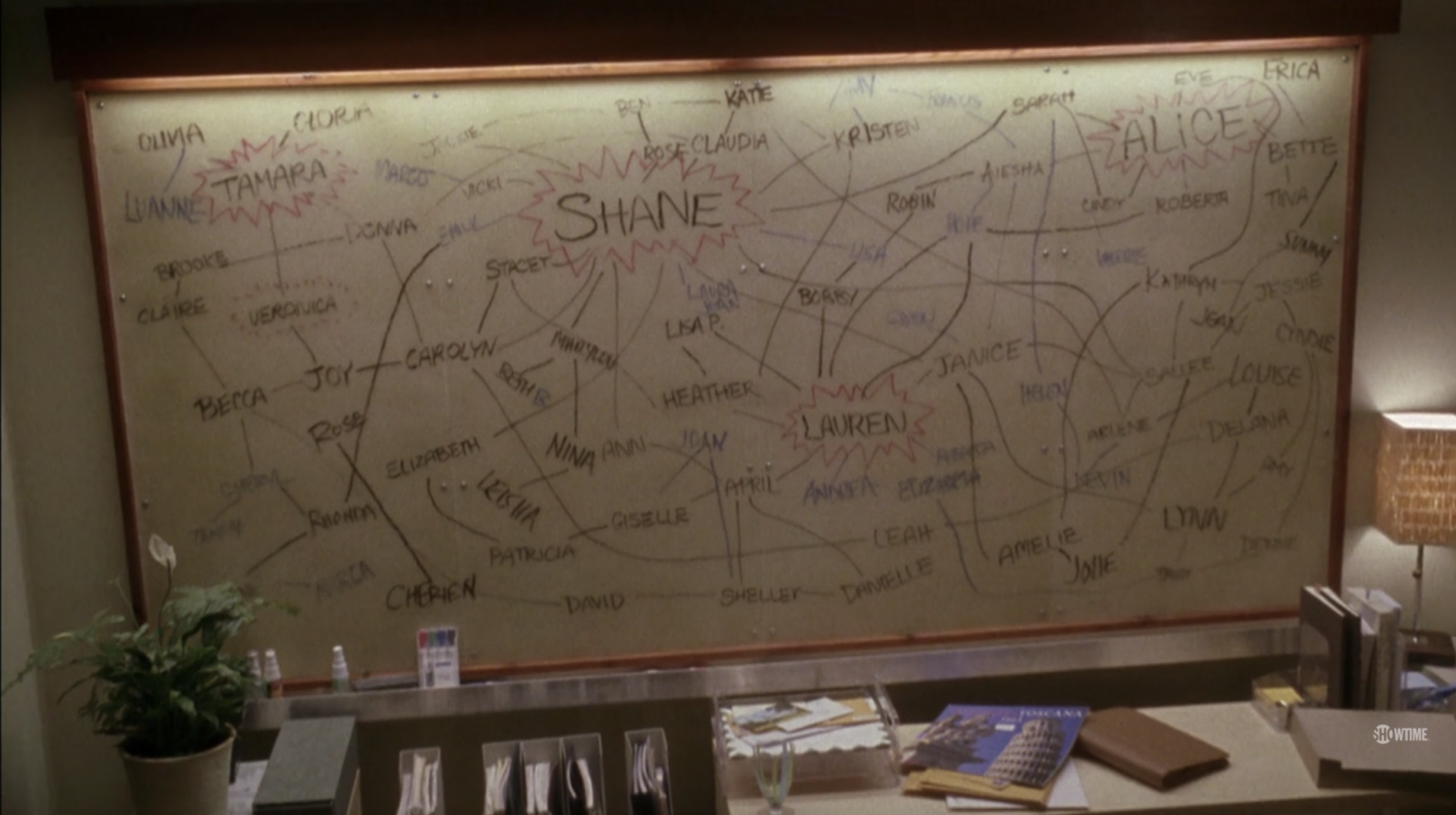- The Ghosts of Emily Dickinson: Hauntings in Popular Culture
- Introduction: Which Dickinson? by Jeannette Schollaert
- Specters on Screen
- Big Reputations: Celebrity and Temporal Duration in/of Dickinson Lyrics by Elizabeth Dinneny
- Ghosts in the Algorithm: The Dickinsons on TikTok by Elizabeth Dinneny
- "Dickinson-core" by Jeannette Schollaert
- Contributors
- Works Cited
A Queer Visual Poem: Ghosts in the “E-Chart”
Artist Statement by Margaret Rhee
Like “The Chart” featured on the popular television series The L-Word, one could map out the rich, evocative, and creative ties of queer feminist scholarly and creative expressions inspired by Emily Dickinson. Like the queer intimacy of the letters and poetry between Emily and her sister-in-law Susan Gilbert, as formatively researched by Martha Nell Smith and other scholars, the collective artistic and scholarly work on Dickinson’s by women and nonbinary individuals could be understood to be created, inspired by, and watched in relation to one another. Utilizing graphic design, poetry, scholarly communities, “The E-Chart” is a visual poem that aims to demonstrate a mapping of feminist and queer artists and scholars who make up a body of literature, an aesthetic community which include visual art, film, and poetry.
Like the characters in The L-Word, a community of artists and scholars--queer and feminist--are connected by Emily through queer bonds. The “E-Chart” is part of a larger collection of visual poems I’ve created inspired by Dickinson and her baking, poetry, and queerness. In part, I turned to visual poetry as I’ve found neither a poem nor essay could articulate these ideas and exploration I had at this time. Also, as punctuation, subtitle, and an opening, even if unrelated, Audre Lorde’s words on pleasure and poetry seemed most appropriate here.
This visual poem was first performed and shared when invited to read at the 2020 Houghton Library celebration of Emily Dickinson’s birthday party in 2020.

Fig. 1 Image Description: The queer visual poem features type in multiple fonts on a black background, charting connections via variously designed arrows that link various groups. The various groups name Dickinson scholarship, artwork, poetry, media, and baked goods. The title of the image reads “THE E-CHART,” in the top center, with three arrows pointing downwards to the center of the visual poem: bright pink “Emily,” which serves as the “hub.” The center image “hub” is flanked on the top-right by a red script type of “Susan Gilbert” and to the left by a bright pink quote from poet and essayist Audre Lorde. Most of the type in the bottom half of the chart is white, evoking the image of chalk on a chalkboard.

Fig. 2 Image description: Alice’s Chart, mapped out on a whiteboard using black, blue, and red markers. Lines between names criss-cross and sometimes span the entire length of the board. The names Shane, Lauren, Tamara, and Alice are outlined in red zigzag, denoting them as “hubs.” The chart hangs on her wall above a table.
Ghosts in the "E-Chart" by Elizabeth Dinneny and Jeannette Schollaert
Of The L Word’s many contributions to queer media, the Chart is perhaps its most iconic. Introduced in the second episode of the series, the Chart was created by Alice Piazecki (Leisha Hailey) to demonstrate that all lesbians in LA are connected by their sexual encounters with one another. Alice demonstrates this by tracking “how many people it would take to connect” her to friend Dana (Erin Daniels), who had only slept with two women (“Pilot”). While she is primarily interested in tracking connections within the lesbian community, Alice insists that the Chart demonstrates the interrelation of all people. She tells Marc, a straight man, “All of us, in our isolation...we reach out from the darkness, from the alienation of modern life, to form these connections…I think it’s a really profound statement about the nature of human existence” (“Let’s Do It”). While the Chart reveals that certain interrelated groups of people conglomerate into “solar systems,” it also shows that such systems are always connected to others, even if only tenuously. Mapping out invisible webs of relation, the Chart reveals the circulation of love, anger, betrayal, and other affective connections that constitute community.
Margaret Rhee’s The E-Chart similarly traces affective networks between Emily Dickinson’s readers and beyond. Emily is the “hub,” or the central point of the chart, directly connected to names like Susan Gilbert and Dickinson. Rhee’s poem notably utilizes arrows rather than lines, more clearly denoting the direction of the chart’s circulations. The arrows, whether directly or indirectly, point toward “Emily,” thus emphasizing the constructedness of Emily herself by these individuals and their texts. This central ghost of Emily combines interpretations and artistic representations that are themselves interrelated through histories of reception and feeling. Underlined by the well-known Dickinson phrase, “I Dwell in Possibility,” Emily’s queer and feminist solar system remains open to further connections.
The queer visual poem offers a map to the “constellation” of Dickinson’s hauntings. Set in white type against a black background with punches of bright pink and red colors, Rhee’s work demonstrates the wide-ranging influence of Emily Dickinson in popular culture, literary scholarship, and literary production. By using a framework inspired by The L-Word, Rhee implicitly locates her work in the popular culture imaginary. Emily’s place at the center of the hub acknowledges her prominence in the cultural imaginary, but even as Dickinson plays a central role here, her connection to some of the works included in the constellation of the queer visual poem is more spectral than central. For instance, the circle of works most close to Dickinson’s hub, the first ring of orbit, we might say, includes from left to right, Audre Lorde, Judy Chicago, Brenda Hillman, Claudia Rankine, Alena Smith, Leslie Dill, and Susan Gilbert (notably, not Susan’s married surname of Dickinson, but Susan’s maiden name). This ring of the constellation includes artists and writers and the love of Dickinson’s life, but it also privileges artists whose work directly speaks in conversation with Dickinson’s own life and lyrics -- if not her exact words, like Hillman, Rankine, and Dill, but the spirit in which we might read Dickinson’s work, like in Lorde’s passage. This first degree of connection allows us to acknowledge the work of those artists for whom the ghost of Dickinson perhaps appears more directly, before moving further outwards to those who grapple with different apparitions of Dickinson, more scholarly but no less personal hauntings. Rhee’s queer visual poem offers a map of Dickinson’s ghostly travels through poetry, art, television, film, and scholarship, offering insight into the myriad ways in which Dickinson haunts so many facets of the American cultural imaginary.



